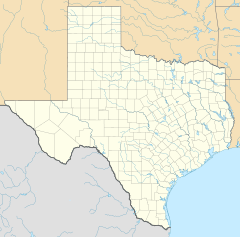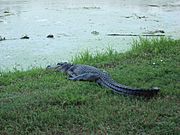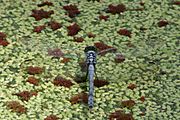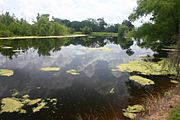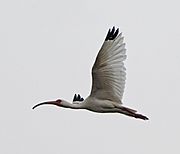Brazos Bend State Park facts for kids
Quick facts for kids Brazos Bend State Park |
|
|---|---|
 |
|
| Location | Fort Bend County, Texas |
| Nearest city | Needville, Texas |
| Area | 4,897 acres (19.82 km2) |
| Established | 1984 |
| Governing body | Texas Parks and Wildlife Department |
Brazos Bend State Park is a huge park in Texas, covering about 4,897 acres. It's located along the Brazos River in Fort Bend County. The Texas Parks and Wildlife Department runs this amazing park.
Brazos Bend is a special place for many different animals and plants. You can find coastal grasslands, thick forests, and lots of wetlands here. These wetlands include lakes and marshy areas. The park is home to over 300 types of birds. You might also spot white-tailed deer, nine-banded armadillos, raccoons, and North American river otters. But the most famous residents are the many American alligators! The park is open all year, except for a few weekends when it closes for deer management.
Contents
Discovering Brazos Bend's Past
Brazos Bend State Park sits on land next to the Brazos River. It includes low areas that were once part of the river's path. Long ago, Native American groups lived here. The Karankawa people were some of the most well-known.
Over time, different people owned the land. Some old buildings from those days are still in the park. For example, there's a brick cistern (a tank for collecting water). The park's nature center is even built inside an old hunting cabin!
People also made changes to the park's lakes and water areas. This helped with fun activities and flood control. A raised walkway goes around some of the bigger lakes, like Elm Lake. Even though changes were made in the past, the park now tries to keep things natural. It also balances this with fun activities for visitors. The park officially opened in 1984. The land was given to the state a few years before that. In 2009, the park celebrated its 25th birthday! Today, volunteers help the Texas Parks and Wildlife Department run the park.
Fun Things to Do at Brazos Bend
Brazos Bend is mostly a natural park. It has areas for day visits, like picnic spots and a campground. But the best way to have fun here is to enjoy nature! You can go hiking, fishing, and watch for wildlife.
Many people love to go bird watching here. Brazos Bend is on a major bird migration path called the Central Flyway. This means you can see many different birds, especially when they are migrating. The park also offers programs for Scouting groups. There's an orienteering course, which is like a treasure hunt using a map and compass. It's also a popular spot for geocaching, another type of modern treasure hunt!
Learning at Brazos Bend
The park staff and volunteers offer many educational programs every week. They also visit local schools and groups. Some popular programs include guided bird walks and photography hikes. You can also learn about alligators and snakes. Guided walks around Creekfield Lake are also popular.
The park also has crafts, story times, and other fun learning activities. The volunteers run a Nature Center. Inside, you can see live snakes that live in the park. They also have baby alligators! The center has many displays and activities to help you learn about nature.
Special Events All Year Long
Besides the weekly programs, Brazos Bend hosts many annual events. Some highlights include the "A Simple Christmas" celebration. There are also "Prairie Heritage Days" and a "July 4th Bike Parade."
The park also works with other groups for special events. They take part in the Christmas Bird Count and the Butterfly count. These are big efforts by the Audubon Society and the North American Butterfly Association. Brazos Bend State Park's Christmas Bird Count is often one of the best in North America!
Explore the Stars at George Observatory
| see List of minor planets § Main index |
Brazos Bend State Park is also home to the George Observatory. This observatory is part of the Houston Museum of Natural Science. It has three large telescopes inside domes. The biggest one is the Gueymard Research Telescope. It has a huge lens that is 36 inches across!
The observatory focuses on teaching people about space. It has a Challenger Learning Center for space science education. You can also see an exhibit of meteorites there. It's a great place to learn about the stars and planets!
Gallery


